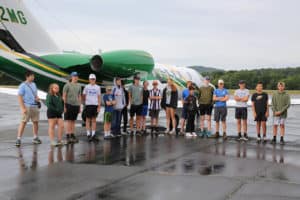After a two-year hiatus due to the pandemic, Aviation Careers Education Camp, “ACE Camp,” returned last week to Hartness State Airport in Springfield. Seventeen students from across the region explored a wide range of career opportunities in aviation and aerospace, built rockets and airplane wing ribs, and flew in aircraft ranging from a hot air balloon to a corporate jet.
Chris Caputo from Beta Technologies, the Burlington start-up developing an electric aircraft, kicked off the week-long day camp explaining BETA’s strategy to secure a position in the high value small package airborne delivery market. Prior to joining Beta, Chris had a 31-year career in the U.S. Air Force flying the A-10 Warthog and F-16 fighter. He’s now a flight instructor with Beta, and flew from Beta’s Burlington International Airport headquarters in a 1943 Stearman biplane and provided flights to ACE students.

Students interested in aviation careers learned to fly at the Harness State Airport in Springfield for the Aviation Careers Education Camp.
Following Caputo’s presentation, ACE students flew in New England Soaring Association gliders and a variety of aircraft including a Piper J-3 Cub, an Aeronca Sedan, a 1956 Cessna 182, Vans RV-6, Piper Cherokee 140 and a Beech Sundowner.
Then students traveled to the Lebanon airport, touring the air traffic control tower, Fixed Base Operator Granite Air Center. Airport Manager Carl Gross and the airport maintenance department described their roles in the airport’s daily operations. White Mountains Capital flight department provided a tour of the facility and a talk with pilots just before they launched for a business trip. Cape Air and the TSA presented their operations at Lebanon and the career opportunities available. ACE Camp Lebanon day closed with a visit to the DHART helicopter medevac facility at Dartmouth-Hitchcock Medical Center where the students climbed aboard the helicopters and were able to ask questions to the EMT’s, nurses and pilots.
Robin Guillian from Vermont Tech’s Professional Pilot Technology Program presented the opportunities available through the state college system’s program, and the scholarship funding available.
Scotts Miracle-Gro CEO Jim Hagedorn arranged for two Cessna CJ-4 business jets, a WW2 era P-51 Mustang fighter, and a MD500 helicopter to fly each of the students. The five Scotts pilots flew the P-51 and a Citation jet from Columbus, Ohio, arriving in Springfield just as the rain was letting up. Hagedorn spoke at length with the students about his career as an Air Force F-16 pilot and how the P-51 helped turn the tide to the Allies during WW2. Hagedorn and the Scotts pilots then did safety briefings with the students, specific to the aircraft they were about to fly in, and all went flying.
The last day of camp began with a spectacular sunrise balloon launch by Paul Stumpf Balloons. Stumpf directed the students to lay out and fill the balloon envelope, then took all for a tethered flight. Then followed “Aerodynamic Lessons from Nature” presented by the Southern Vermont Natural History, a presentation of live raptors.
In addition to all the flying activities, classroom sessions included topics such as “How to get your pilot’s license,” “Calculating the height of your rocket launch,” “Aerodynamics 101,” “Small Aircraft Maintenance”, and other related topics. Aviation and aerospace professionals spoke about their careers as airline pilots and “freight dogs,” with local pilot Bill Batesole speaking about his 38 years flying freight for FedEx and Upper Valley resident Andy Gelston speaking about his career as an engineer at NASA working on the space shuttle program.
ACE Camp has been held most summers at Hartness Airport since at least 2012.




